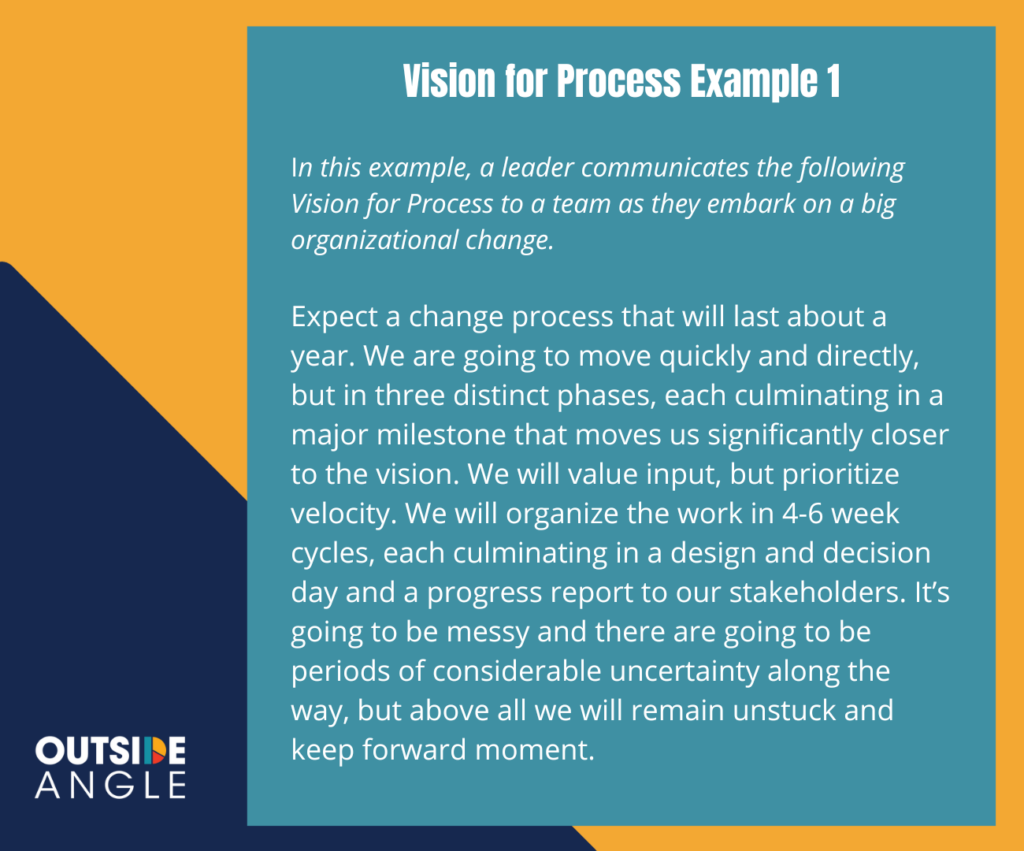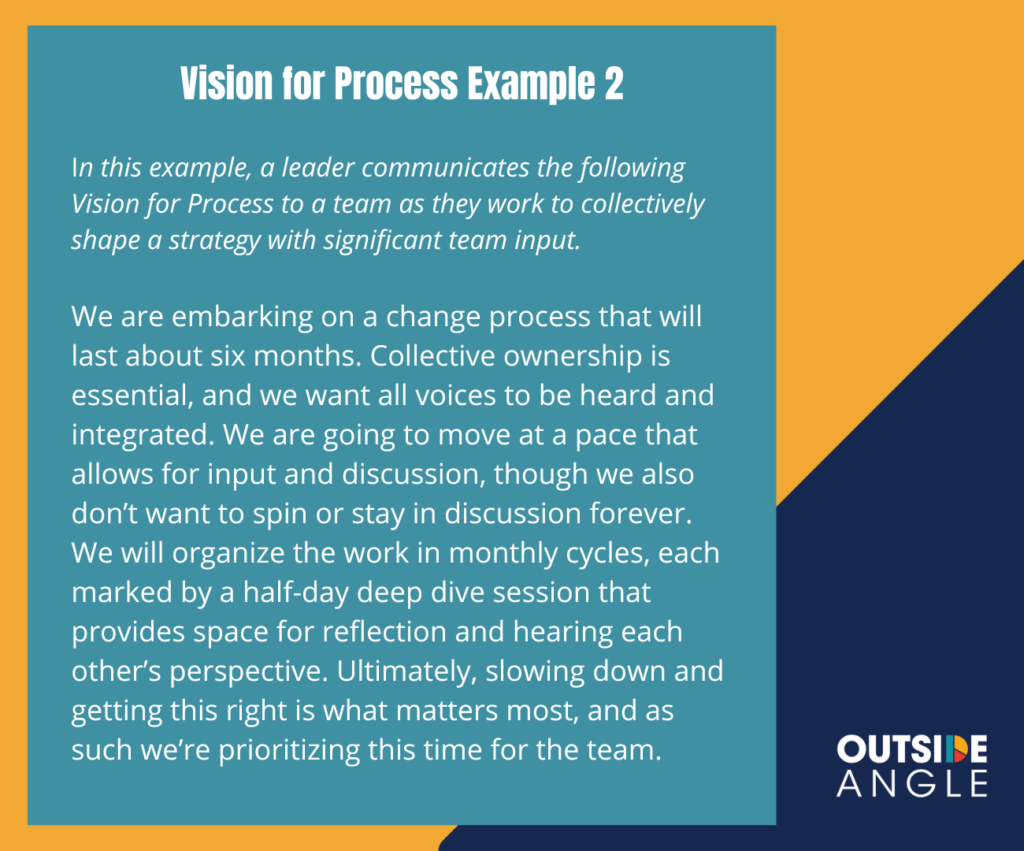Introduction
All change efforts begin with the recognition that something just isn’t working. Sometimes the solution is clear, but often people can only agree on the pain being caused by the problem. How the problem is solved often depends on the skills of the leader.
Vision vs. Process
Leaders who are particularly strong at developing vision tend to invest time and energy into defining what it looks like when the problem is solved, and painting a picture of a future that will be brighter thanks to their change. They may even describe “what” the target is in detail, capable of inspiring action—but not a clear “how” that clarifies which action to take.
By contrast, leaders who are indexed toward building process tend to jump deep into the weeds of process. They work on meeting agendas, budgets, timelines, capacity needs. The result may be more immediate action, but their teams often struggle to navigate roadblocks or barriers that arise along the way because they’re not clear on the target they’re aiming for.
Both of these are important, but they skip the critical link that connects Vision and Process together at the highest level.
Vision for Process
Even when leaders do effectively address both vision and process, they often neglect the link between the two that helps people understand the philosophy and intent behind the process and the ways the process itself might need to evolve based upon how the process plays out.
We’ve seen this key element missed so many times that we’ve decided to give it a name: Vision for Process. In this post, we explain the term Vision for Process and why it matters. We also provide some tips for how to create one, and what success looks like when you do. In doing so we hope that it will help more teams spend time at this crucial intersection between the “what” and the “how.”
The Importance of Vision for Process
Imagine setting off on a road trip without a map or GPS. You know your destination, but you have no idea how to get there. This scenario parallels the challenge faced by many organizations when they have a vision but lack a complementary vision for the process.
Without a shared story of the journey the team will traverse to move from the present to the future, change efforts can easily lose their way, leaving employees and stakeholders feeling lost and frustrated. Vision for process is not a mere technicality; it’s an essential component of successful change management. Here’s why:
- Aligning Strategy with Execution: A vision for process ensures that the chosen path aligns with the overarching strategic objectives. It bridges the gap between high-level strategy and the nitty-gritty details of implementation, allowing organizations to maintain focus and consistency.
- Contextual Adaptation: Every organization is unique, and the path to change should reflect this individuality. A vision for process involves studying the current context, including organizational culture, capabilities, and constraints, and developing a process that takes these factors into account. It’s about making the process fit the organization, not the other way around.
- Decision Making and Empowerment: Without a vision for process, decision-making can become ad-hoc and inconsistent. A well-defined process vision provides a structured framework for making decisions, empowering teams to act with confidence and autonomy.
- Managing Change Fatigue: Change can be challenging—especially in the “middle” when initial excitement has faded but the new work is not yet yielding results. This is when organizations often face resistance from those who believe the intended change has already failed. A clear vision for process helps manage change fatigue by offering a roadmap that demystifies the journey ahead, making it less overwhelming or demoralizing for employees.
Vision for Process is the story of the journey. It tells people how the change process will unfold, what it will feel like, and how they will move together from where they are to the future vision. Crafting the Vision for Process is equal in importance to the vision itself. Without it, everyone will just try to get there in the best way they know how.
What Success Looks Like
An effectively crafted Vision for Process should be simple and story-like, making it easy to remember. At the same time, it packs in a ton of valuable information that helps people align on how they should proceed, and what they should expect. Here are some helpful questions to answer when crafting yours.
- How long do we think it will take?
- How direct/indirect of a path will we take to get there?
- Which matters more: velocity or consensus?
- How are we going to organize the journey?
- What do we expect the journey to feel like?
- What will we do if/when we get disconfirming information?
The right answer to these questions is highly contextual, which is part of the reason change leadership is so hard. Where a top-down, aggressive process would be fatal to one change project, a deliberate, consensus-driven approach would be catastrophic in another. Similarly, whereas one change project would feel like an unassailable blob if not broken down into discrete phases, that same approach might only complicate another project unnecessarily.
By answering these simple questions, you will be able to begin to tell a clear and consistent story that sets expectations and starts to align behaviors.


Creating the Vision for Process
Developing a Vision for Process is a creative endeavor that parallels envisioning the desired solution itself. Here are some steps to guide you in creating this essential component of change efforts:
- Draft your story in context: Approach the story from the perspective of someone who is already operating in the current culture. How are stories told? How will this story need to highlight what will be different?
- Test your story: Terry Pratchett wrote that “the best research is talk to people” — and this is a prime example. Test your story and make revisions for clarity and engagement. Your job is to drive enthusiasm and understanding so that your team is inspired to act.
- Tell the story again and again: Just like the vision itself, you’ll need to be a broken record. The more you explain the Vision for Process the more people will start to understand it, own it, and organize their own work accordingly.
Stay on message. There will be a strong pull to abandon anything that doesn’t immediately work.
Conclusion
Even when vision and process are strong, the Vision for Process is the missing link that can make or break success. While it’s essential to have a clear vision of the “what,” it’s equally crucial to have a well-defined roadmap for the “how.” Vision for Process bridges the gap between strategy and execution, ensuring that organizations stay on track, adapt to their unique context, and empower teams to drive meaningful change.
Remember that creating a vision for process is a creative endeavor that demands careful consideration, collaboration, and adaptability. By investing in this vital component of change management, organizations can navigate the journey from where they are to where they want to be with confidence and purpose.

